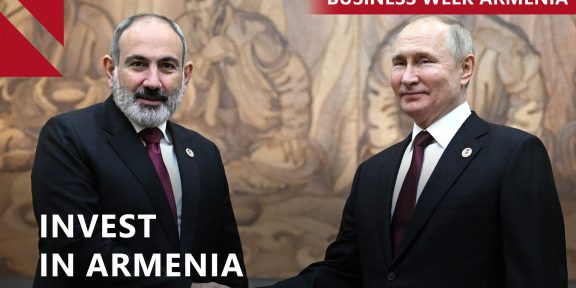By Mark Dovich
Last month, a common aviation area agreement between the European Union and Armenia entered into administrative application, committing Armenia to align its domestic legislation more closely with EU standards and regulations in air safety, among other related fields.
The development has refocused attention in Armenia on the country’s partnership agreement with the EU, of which the aviation deal is just one small part.
CivilNet spoke with Karen Azaryan, a trade officer at the EU delegation to Armenia, to explain the history of the agreement, what exactly it entails, and how it is expected to impact Armenia’s economy. Azaryan also discussed common misconceptions about the deal in Armenia.
What’s the history behind CEPA?
In 2017, Yerevan and Brussels inked a comprehensive and enhanced partnership agreement in an effort to advance their cooperation in a wide range of fields, including trade and economic relations. It entered provisional application in 2018, and then formally came into force in 2021.
The deal was hailed by both sides: Armenian Deputy Prime Minister Mher Grigoryan pledged that “its implementation is one of the government’s priorities,” while the EU called it an “important milestone.”
CEPA is largely based on a previous round of negotiations between Armenia and the EU aimed at reaching an association agreement that would set up a so-called deep and comprehensive free trade area.
Then-Armenian President Serzh Sargsyan scrapped the deal at the last minute in 2013 after meeting with Russian President Vladimir Putin. Armenia then joined the Eurasian Economic Union, a Russian-led trade bloc, instead.
“The EU said that it’s not possible to have a DCFTA in these conditions, because if Armenia is part of another customs union, then it does not have independence in foreign trade policy and does not have total authority on its tariffs,” Azaryan said, describing the thinking in Brussels at the time.
In 2015, the Armenian government relaunched talks with the EU, looking to salvage as much of the previous deal as possible. The result was CEPA.
“It has most parts of the association agreement and DCFTA negotiated from 2010 to 2013. Only the tariff part is missing,” Azaryan said. “This is why it’s quite an ambitious agreement.”
What exactly does CEPA entail?
CEPA envisages a gradual liberalization of bilateral trade between Armenia and the EU.
“The agreement covers all aspects of trade, so it can be public procurement, it can be sanitary and phytosanitary measures, it is technical barriers to trade, it is also customs, it includes competition — they are all covered,” Azaryan explained.
In addition, the agreement commits the Armenian government to adopt laws that more closely approximate EU legislation, with a focus on mirroring European standards and regulations.
“The EU is one of the leading developed trading blocs in the world, with really advanced standards, technologies, and regulations,” Azaryan said. “These are already-working, effectively working standards and regulations that (Armenia) can just adapt to its local environment.”
Close legislative alignment is expected to make trade between Yerevan and Brussels more seamless. The EU is already one of Armenia’s biggest economic partners, with trade topping $2.3 billion last year, according to Armenia’s Statistical Committee.
What’s the expected impact for Armenia?
Brussels anticipates that CEPA will help raise living standards in Armenia. By making it easier for Armenian companies to export to the EU, while also making Armenia a more attractive investment destination for European companies, the deal is anticipated to be a major driver of new job creation.
“If we really can develop stronger ties in the economy, then we make Armenian businesses stronger,” Andrea Wiktorin, the head of the EU delegation to Armenia, told CivilNet in a 2021 interview. “We can do more together in the green economy, we can work together in sustainable energy. These are all areas where we can create jobs.”
Beyond trade, another key plank of the agreement is meant to encourage Armenia’s ongoing democratization process, including reforms meant to increase government transparency and accountability. The deal also envisages major changes to Armenia’s judicial system, policing policies, and electoral rules.
No more Armenian ‘cognac’
One stipulation found in CEPA’s thousands of pages in particular has attracted much attention in Armenia: article 237, which commits Armenian liquor producers to stop labeling their brandy products as ‘cognac’ within 25 years.
The reason for the change lies in the EU’s geographical indication system, a form of intellectual property rights that ties products to the places where they are produced. Under EU law, ‘cognac’ can refer only to brandy made in France’s Cognac region.
Commenting on the EU’s decision to give Armenian brandy producers more than two decades to comply, Azaryan said: “I don’t recall any other agreement where there will be such a long phasing-out period.”
The change could have serious economic consequences for Armenia, where around 7% of yearly exports are shipments of hard liquor. The vast majority of Armenia’s brandy is sent to Russia and other former Soviet countries, where it is widely known as ‘cognac.’
But Azaryan sought to allay fears CEPA could harm Armenia’s brandy industry, noting that the agreement also contains provisions committing Brussels to provide assistance marketing Armenian brandy under a new, as-yet-unchosen name.
He also pointed to previous instances when other products were renamed or relabeled over GI concerns.
“There are success stories here,” Azaryan stressed. “Take cava, for example. It’s Spanish sparkling wine, but it used to be called ‘Spanish champagne.’ France insisted that Spain change it, and Spain respected the partner country’s GI. Now it’s called ‘cava,’ and it’s still very popular.”
Is CEPA a free trade agreement?
No, CEPA is not a free trade agreement. It is a legal basis for Armenia-EU cooperation that includes a trade liberalization component, among others. Brussels has consistently said that Armenia’s membership in the Eurasian Economic Union makes it ineligible for a full-fledged free trade deal.
Is CEPA related to Armenia’s exit from the EU’s preferential trade program?
No, CEPA is totally unrelated to Armenia’s exit last year from the Generalized Scheme of Preferences Plus, the EU’s preferential trade regime. Through the program, Brussels unilaterally lowered or removed tariffs on over 6,000 products for Yerevan. Armenia’s trade with the EU more than tripled under GSP+.
Armenia exited the program last year after having been classified as an upper middle income country for three consecutive years by the World Bank, which had previously considered Armenia as a lower middle income country. Under EU rules, any GSP+ beneficiary country that has been classified as an upper middle income country by the World Bank for three years in a row loses eligibility.
DONATE















